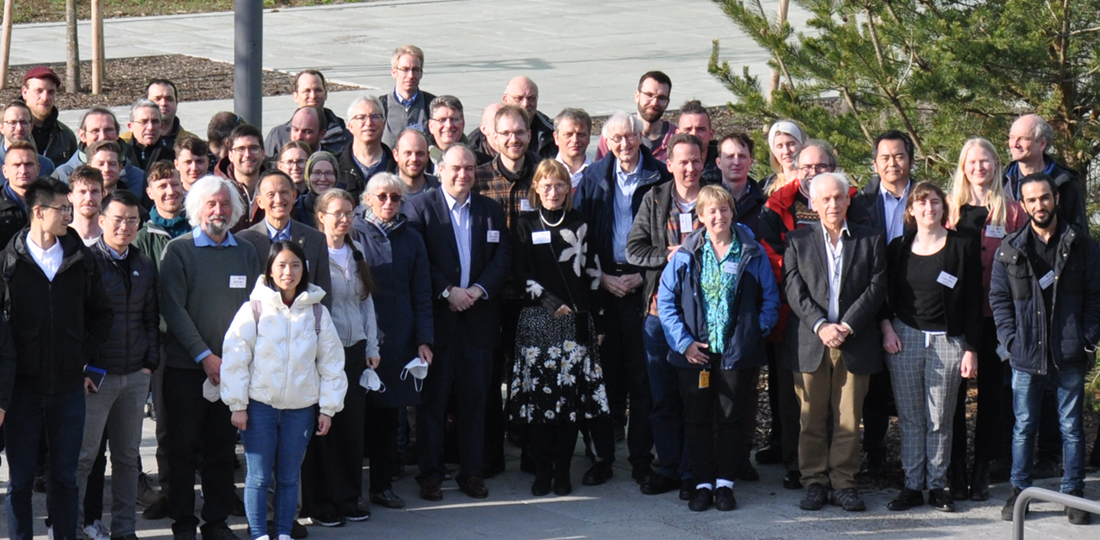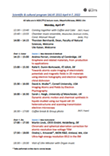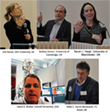Fourth SALVE symposium 2022 held at the University of Ulm
April 04-07, 2022 - The SALVE (Sub-Ångstrom Low Voltage Electron microscopy) Symposium 2022 (SALVE 2D22), organized by Ute Kaiser, was held from 04th to 07th of April at Ulm University. The symposium brought together distinguished scientists from 14 countries (Figs. 2,17). After the opening of the symposium by the dean of the faculty of natural science of Ulm University, Prof. Thorsten Bernhardt, the symposium was officially opened by Prof. Ute Kaiser. The introductory lecture was given by Prof. Andrea Ferrari, who discussed future prospects and business opportunities with 2D materials. The symposium contained 12 oral presentation sessions. In a poster session, recent results of the SALVE microscopy center were presented. The symposium was dedicated to discuss research on low-voltage S/TEM for low-dimensional materials, their fabrication, property calculation and modification.

Figure 2: A snapshot of some participants of day one of the SALVE Symposium 2022. Snapshots of the sessions and discussions are shown in Figs. 3-16. A group photo with participants from 14 countries is shown in Fig. 17.
The meeting consisted of four days with 12 focus sessions with the topics "New Materials & Methods", "New Instruments", "Low-D Materials: Synthesis, Characterization and Calculations", "In-situ TEM of low-D materials", "SEM-STEM of low-D materials", "New methods", "Microscopy and Spectroscopy on low-D materials", "Low-D Materials Properties", and "New Horizons" as well as many discussion rounds, where the participants lively discussed the further advancement of low-voltage electron microscopy.
Sessions 1 “New Materials & Methods” chaired by Ute Kaiser (Ulm University, Germany)
Prof. Andea Ferrari (Cambridge University, UK) gave an introduction with the title "Quo vadis 2D materials?". The head of the EU research program "Graphene Flagship" discussed examples where practical, environmentally friendly and energy-efficient applications had been succesfully brought into businesses. He discussed the effect of the atomic structure of the materials that determines the application properties to his audience, from the experts in electron microscopy and researchers in materials science to the scientists who theoretically calculate material properties.
In the following talk, Prof. Rafal E. Dunin-Borkowski (FZ Jülich, Germany) discussed new routes towards the atomic-scale imaging of electrostatic potentials and magnetic fields in 2D materials by applying electron holography and electron magnetic chiral dichroism. Prof. David A. Muller (Cornell University, USA) then presented the imaging of atoms and fields by electron ptychography. The dynamic atomic motion and chemical synthesis in liquids was the topic of the talk of Prof. Sarah Haigh (Manchester University, UK). She prsented studies on liquid cell 2D heterostructures by STEM.
Sessions 2 “New Instruments” chaired by Yimei Zhu (BNL, USA)
In this meeting, the companies CEOS GmbH and Nion Company presented their latest developments related to low-voltage TEM/STEM imaging. Heiko Müller (CEOS GmbH, Germany) reported on the chromatic and spherical aberration correction for atomic-resolution low-voltage TEM. Ondrej Krivanek (Nion, USA) reported ultra-high energy resolution EELS in the STEM.
Sessions 3, 4, 7 “Low-D Materials - Synthesis, Characterization and Calculations (I-III)” chairs: Eva Olsen (Chalmers University, Sweden), Frances Ross (IBM, USA)
In three session, eight talks were reporting on the recent progress in the synthesis and characterization of low-D materials. Prof. Kazu Suenaga (Osaka University, JP) presented electron microscopy and spectroscopy on 2D hybrid materials. Prof. Reshef Tenne (Weizmann institute, Israel) reported on the preparation of new inorganic nanotubes (INT) from WS2 to "misfit" compounds. Prof. Jannik Meyer (University Tübingen, Germany) demonstrated chemical identification on the single atom level in the presence of noise and residual aberrations. Prof. Georg Düsberg (Universität der Bundeswehr, Germany) demonstrated new results on transition metal dichalocogenides for electronic applications. Prof. Xinliang Feng (TU Dresden, Germany) reported on his new results on organic 2D Crystals. Prof. Yimei Zhu (BNL, USA) reported on cryogenic Electron Microscopy on Strongly Correlated Quantum Materials. Colin Humphreys (Queen Mary University of London, UK) reported on making optoelectronic devices from large-area transfer-free MOCVD graphene: Hall sensors and OLEDs. Manuel Reinhard (JEOL GmbH, Germany) reported on pulsed laser integration and electrostatic systems for dose modulation and temporal resolution TEM.
Session 5 “In-situ TEM of low D materials”, chair: Christoph Koch
Prof. Frances Ross (MIT, Cambridge, USA) reported on strategies for local control of the properties of the 2D layered magnet CrSBr. Prof. Eva Olsson (Chalmers, Gothenburg, SE) prsented results on strain induced changes in electrical, optical and structural properties from her in situ studies. Prof. Erdmann Spiecker (Universität Erlangen-Nürnberg, Germany) reported on the application of 4D scanning confocal electron diffraction (4DSCED). The technique can be used for studying structural evolution in organic 2D materials and thin films at a realtively low dose. Finally, Prof. Andrei Khlobystov (University of Nottingham, UK) described the analysis of the chemistry of individual molecules using transmission electron microscopy.
Session 6 “SEM-STEM of low-D materials”, chair: Jannik Meyer
Dr. Jon Weiss from the company TESCAN (USA) reported examples of application-driven instrument design for next- generation nanocharacterization tools. STEM at electron energies of 30 keV and below was addressed in the talk of Prof. Dagmar Gerthsen (KIT, Germany) on the minimization of contamination. The last speaker in the session was Prof. Rasmus Schröder (University Heidelberg, Germany), who adressed backscattering EELS, at ultra-low landing energies.
Session 8 “New methods”, chaired by Dagmar Gerthsen
Recent advanced in ultrafast electron microscopy were prsented by Prof. Claus Ropers (MPI Göttingen, Germany) Prof. Christoph Koch (HU Berlin, Germany) prsented the reconstruction of 2D and 3D atomic structure from various TEM data. Prof Christopher Russo (MRC, UK) described the molecular structure determination extrapolated to zero dose with an electron cryomicroscope and Prof. Tatiana Latychevskaia (PSI, Switzerland) reported on convergent beam electron diffraction (CBED) of two-dimensional (2D) materials.
Sessions 9, 10 “Microscopy and Spectroscopy on low-D materials (I-II)”, chaired by Thomas Pichler and Wolfgang Jäger
In the first session on this sub-topic "Microscopy and Spectroscopy", session 9, Prof. Jani Kotakoski (University of Vienna, Austria) reported on in- and ex-situ (S)TEM manipulation of 2D materials without air exposure. Prof. Michael Stöger-Pollach (TU Wien, Austria) presented new results on the excitations of materials at low beam energies. Dr. Ivan Lazić from the company Thermo Fisher Scientific (Netherlands) gave an overview on their results of imaging of 2D materials using electrons down to 30 keV Dr. Saleh Gorji from the company Ametek GmbH (Germany) discused latest developments in EELS.
In session 10, Prof. Peter van Aken (MPI Festkörperphysik, Germany) discussed atomic-scale investigation of structure and electron-beam-induced transformation of beam-sensitive molecules. Prof. Toma Susi (University of Vienna, Austria) prsented the "abTEM", Transmission Electron Microscopy from first principles. Prof. Arkady Krasheninnikov (HZDR, Germany) also discussed simulation results, for identifying defects and new phases in 2D materials.
Sessions 11 “Low D Materials Properties”, chaired by Clauss Ropers
In this session, prof. Wu Zhou (University of Chinese Academy of Sciences, China) reported on results at atomic resolution with low voltage STEM-EELS. Prof. Thomas Pichler (University of Vienna, Austria) discussed his experiments on momentum resolved electron energy loss spectroscopy. Prof. Ursel Bangert (University of Limerick, IR) presented the subatomic scale revelation of sites and dynamics of individual atoms, as well as of electric dipole configurations in materials envisaged for quantum device development.
Sessions 12 “New horizons II”, chaired by Peter van Aken
In this session, Prof. Andrey Turchanin (Friedrich-Schiller-University Jena, Germany) reported on the influence of intrinsic and extrinsic defects on the electronic and photonic properties of 2D materials. Prof. Lothar Houben (Weizmann Institute, Israel) presented the phase retrieval from ultrafast focal series of low dose counting mode images. Prof. Joachim Mayer (FZ Jülich, Germnany) disucssed the new role of CT and TEM investigations in the development of battery technologies.
A raising star on the horizon of materials are the two-dimensional quantum systems, ideally suited for low-voltage electron microscopic studies as they are atomically thin and well-defined in thickness, can act as low-background imaging substrates and a single projection image can often describe their atomic arrangement's contrast. Thus, they are a unique platform for understanding structural and electronic properties with single atom precision. The workshop highlighted symbiotic developments between low-voltage electron microscopy and low-D material fabriacation as weil as their property calculation and application. Thus, the workshop intended to create a unique platform for bridging the diverse facets of low-D material science. One key point of the workshop was to deepen the understanding of the interaction of low-energy electrons with matter on the scale of the single atoms.

Figure 17: Group photo after the final meeting day of the Fourth International SALVE Symposium 2022 with participants from 14 countries.
Apart from the lectures, the importance of scientific discussions during the coffee-breaks, dinners and other social activities (visit of the Ulm cathedral, piano concert with Valerij Petasch) must be underlined. The direct contact stimulated the exchange of ideas and establishing of new co-operations and friendship.
Finally, the organization of the events would not be possible without generous financial support of the public institutions and international organizations – the University of Ulm, the German Research Foundation (DFG), the manufactures Thermo Fisher Scientific, CEOS GmbH, Gatan, Ametek, JEOL, Tescan and Nion Co.















